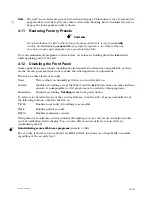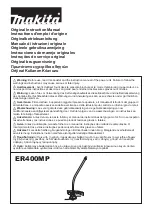
7-1
Rev 2.2, 10/31/94
7. Using the 601.
This chapter is intended for more advanced users. If you are a first-time user, we recommend
that you start out by using the procedure found in "Fast, First-Time Setup." Elsewhere in this
chapter, you can find operational hints and suggested settings. You can find additional
discussion of many of these topics in Chapter 2, "Basics."
7.1 Installation
The 601 may be installed free-standing or rack mounted. No special ventilation requirements
are necessary.
Installation Requirements
Mechanical
One rack space (1.75 inches) required, 12.5 inches depth (including connector
allowance). Rear chassis support recommended for road applications.
Electrical
105-125 V ac, 60 Hz, 20 watts. 210-250V ac, 50 Hz, 20 watts (export version).
Connectors
XLR-3 female for inputs, XLR-3 male for outputs, Pin 2 of the XLR connectors
is "Hot." RCA female connectors for S/PDIF digital I/O. XLR-3 male and female
connectors for AES/EBU digital I/O.
7.2 Operational Details
This section describes the details of operating the 601. Usage information can be found later in
this chapter.
The 601 accepts monaural analog input signals at mic or line level, converts them to 18-bit
digital form, splits them into identical left and right signals, processes them through two
parallel DSP chains, and then converts the signals back to the analog domain. The processed
signals are also simultaneously available at the AES/EBU or S/PDIF output connectors.
The 601 can also process the microphone input through one channel and the line input
through the other channel. The control signal processing is still shared between the two
channels.
Digital signals at either 44.1 kHz or 48 kHz sample rates may be fed directly into the 601 for
processing. The processed signals are available at the outputs as AES/EBU or S/PDIF, and
stereo analog balanced line level. The digital outputs and analog outputs operate
simultaneously. The 601 does not perform dithering or re-dithering.
Regardless of the input source, the 601 always treats its input signals as a stereo pair. With
the exception of the delay line, the 601 always applies identical processing to both signals.
Digital signals may be up to 24-bits wide; the 601 treats all digital signals as if they were
24-bit.
The equalizer is a digital implementation of a common three-band parametric equalizer. The
usual complement of controls may be found and the outside bands may be converted into
shelving equalizers. All bands cover the entire frequency range.
The DS and Noise Reduction block have independent control chains. The Noise Reduction
system implements a variable-frequency low-pass filter controlled by on the relative high-
frequency content of the input signal. The De-esser is a broadband limiter having a sharply
peaked filter in its sidechain.
The Dynamics block is a digital realization of an analog compressor/AGC/expander. A common
log converter provides a logarithmic representation of the amplitude of the input signal to the
components of the Dynamics block. Within the dynamics block, the component having the
greatest amount of instantaneous gain reduction controls the gain of the digitally controlled
attenuators (DCA). An adjustable delay before the DCA allows controlling the amount of
overshoot occurring within the compressor.
Содержание 601
Страница 46: ...4 18 Rev 2 2 10 31 94 This page is blank believe it or not ...
Страница 48: ...4 20 Rev 2 2 10 31 94 Notes ...
Страница 50: ...5 2 Rev 2 2 10 31 94 Notes ...
Страница 70: ...7 16 Rev 2 2 10 31 94 Notes ...
Страница 72: ...8 2 Rev 2 2 10 31 94 Notes ...
Страница 74: ...9 2 Rev 2 2 10 31 94 Notes ...
Страница 78: ...11 2 Rev 2 2 10 31 94 Notes ...
Страница 126: ...D 12 Rev 2 2 10 31 94 Notes ...
Страница 138: ...G 8 Rev 2 2 10 31 94 Notes ...
















































